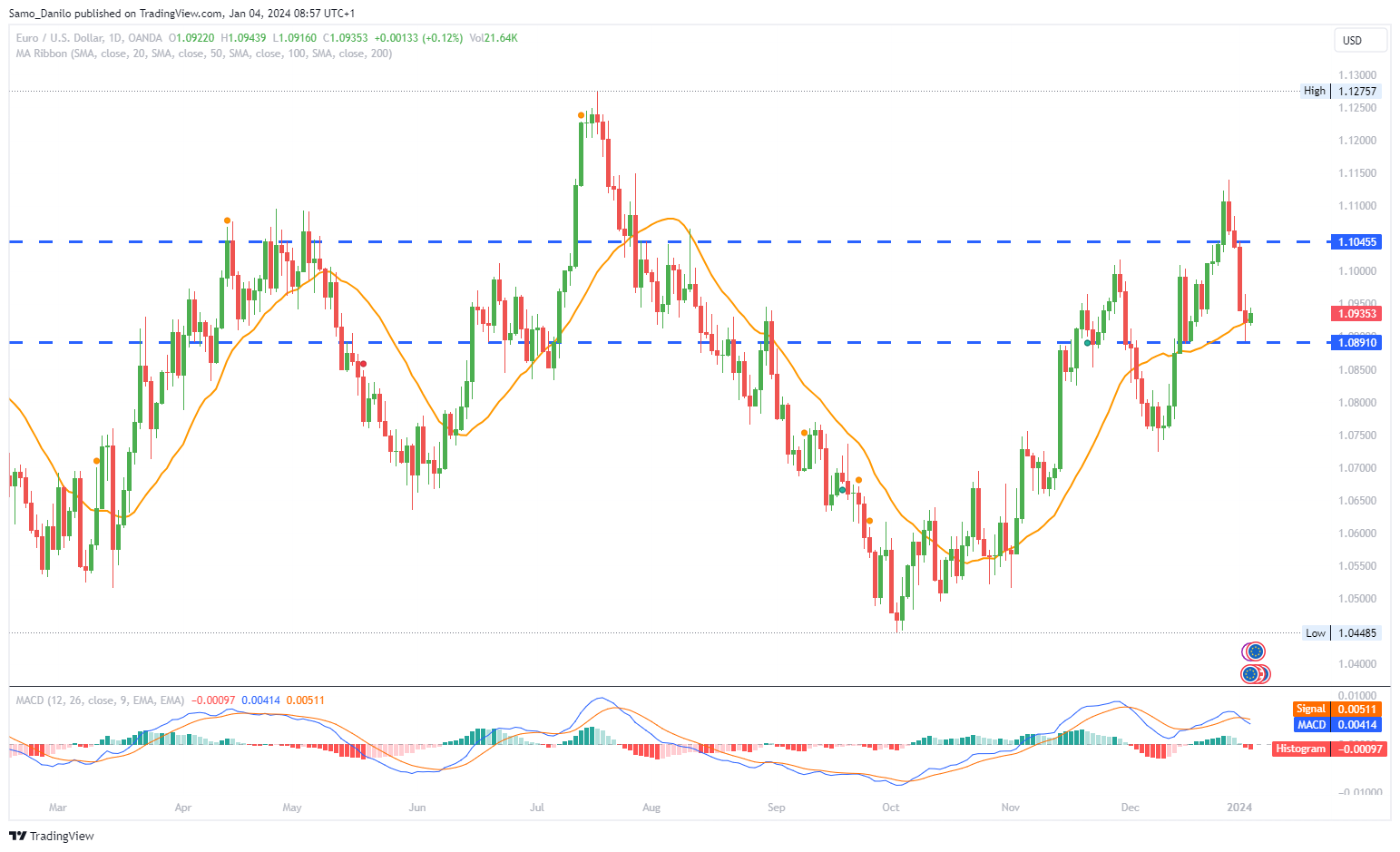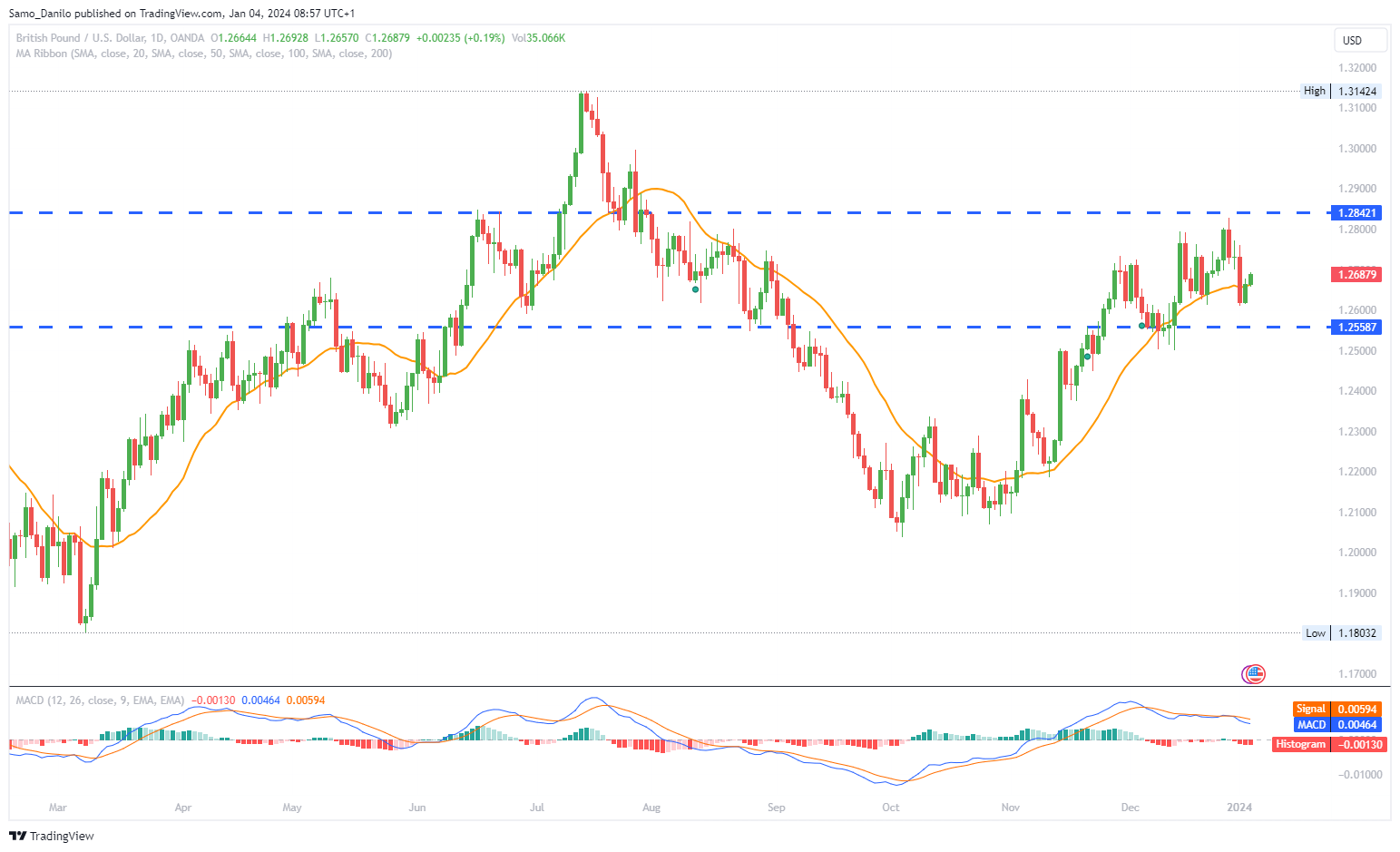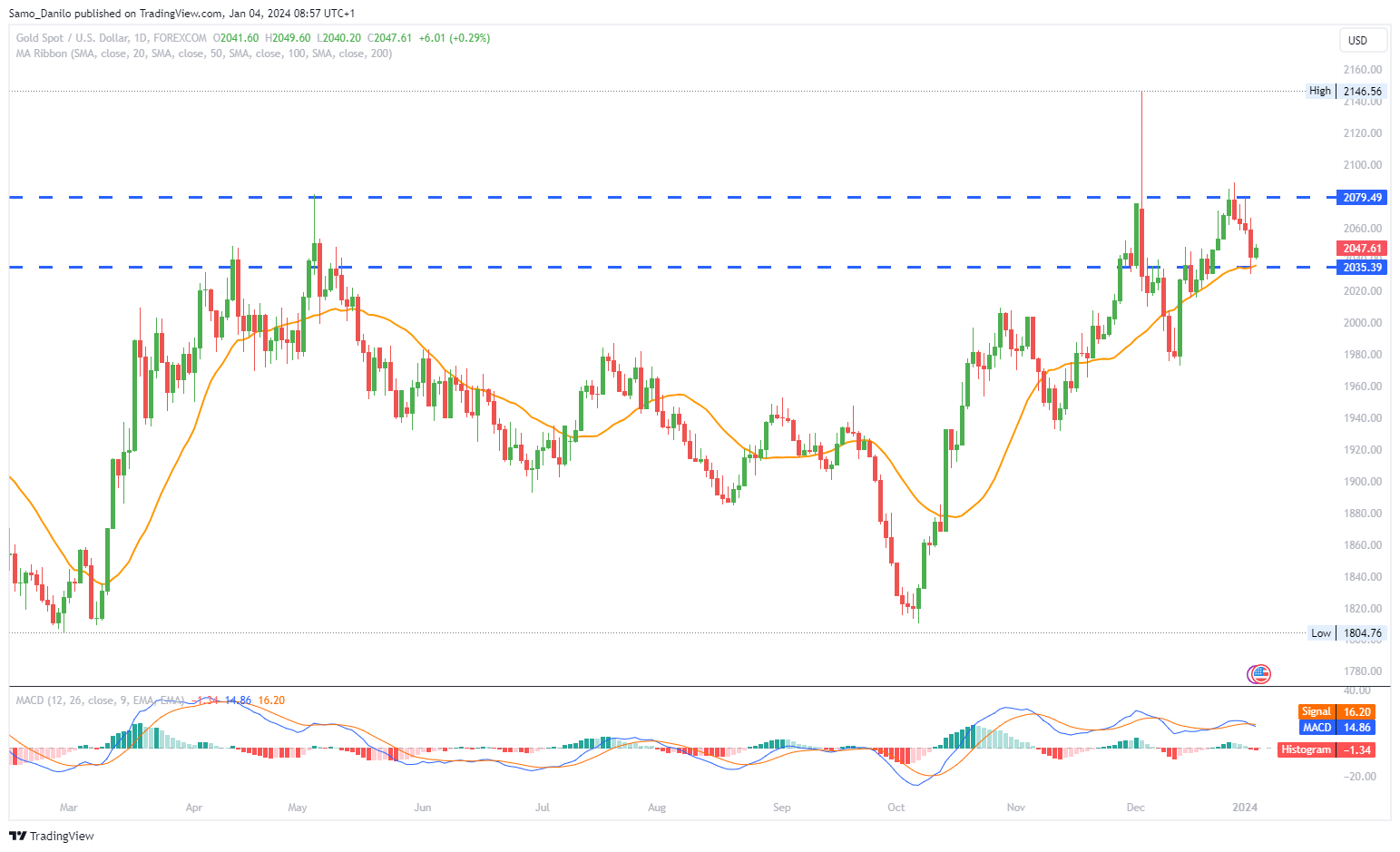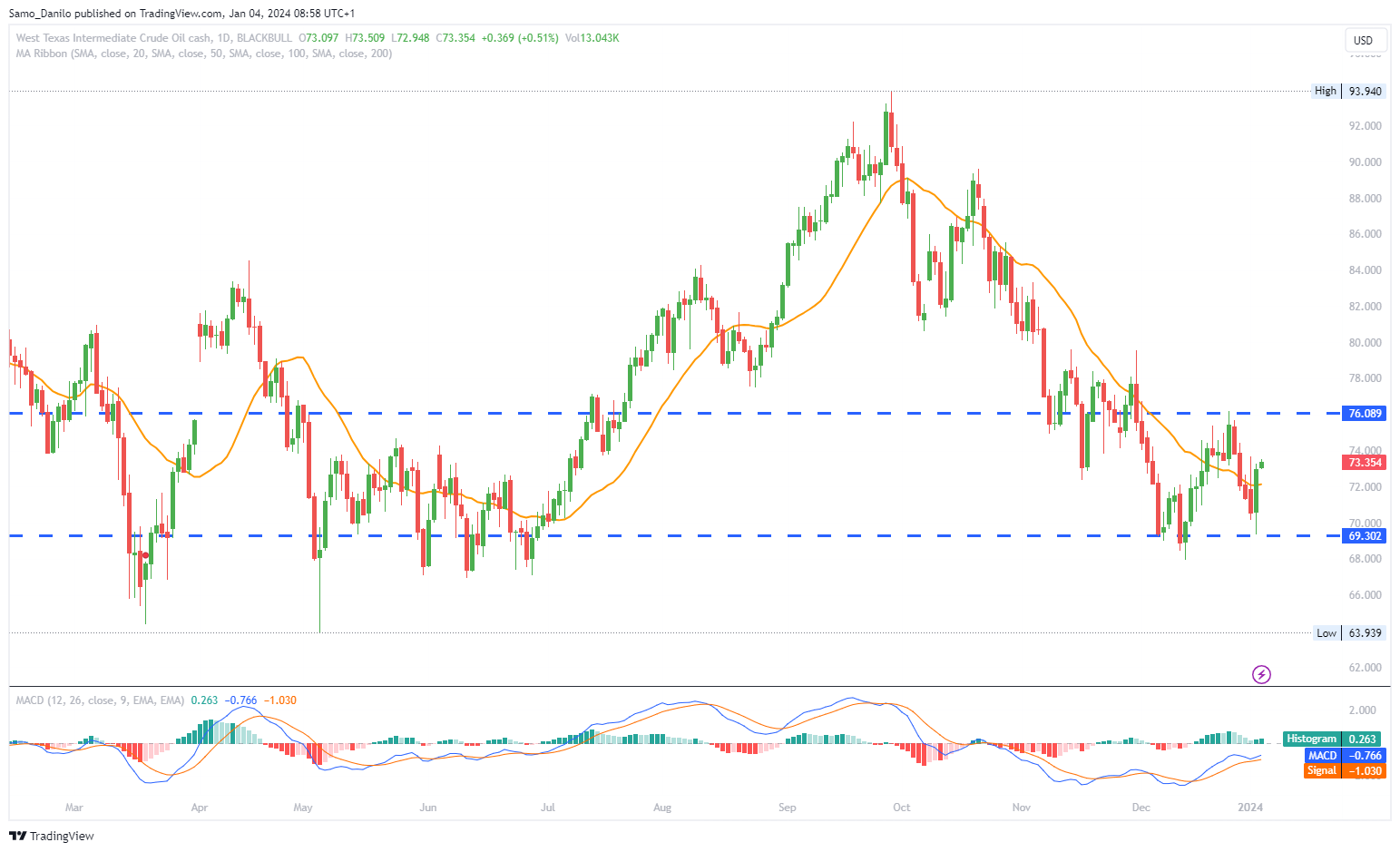EURUSD
- EUR/USD is trying to retrace its recent losses, trading near 1.0920 during the early European hours on Thursday. This retracement signals a potential shift in market sentiment or a corrective move in response to previous losses.
- The recent downward pressure on the EUR/USD was driven by a strengthening US Dollar. This was prompted by a broader market shift towards caution, fueled by concerns about global economic growth as 2024 came to a close.
- Despite a positive job report in Germany, where the labor market showed strength, the Euro failed to find substantial support. The dynamics of the US Dollar were a dominant factor influencing EUR/USD movements.
- Lower-than-expected JOLTs Job Openings for November contributed to a cooling perception of the US labor market. However, the ISM Manufacturing PMI for December surprised to the upside at 47.4, providing a mixed picture of the economic conditions in the US.
- The release of the FOMC Minutes from the December gathering did not lead to significant market movements. However, the minutes revealed that some members suggested that interest rates could have neared peak levels for the present economic cycle. Projections hinted at a lower rate by the calendar year 2024.
Closing statement: EUR/USD remains sensitive to the broader market sentiment, with the US Dollar's strength and economic indicators playing a crucial role. Investors are closely monitoring global economic conditions and central bank statements for insights into future monetary policy decisions.
GBPUSD
- The GBP/USD pair struggles to capitalize on the modest recovery observed in the previous session, hovering near the 1.2600 mark. This level represents a near three-week low for the pair, indicating ongoing challenges for the British Pound (GBP).
- The British Pound faces headwinds as business leaders in the UK express increased pessimism about the economic outlook. This sentiment has led to calls for the Bank of England (BoE) to consider early interest rate cuts in an effort to support the economy.
- Money market pricing reflects traders' expectations of approximately 140 basis points (bps) of rate cuts in 2024. This suggests a cautious outlook for the UK economy and an anticipation of accommodative monetary policy.
- The release of the FOMC Minutes from the December 12-13 meeting did not provide clear signals regarding the timing of potential rate cuts by the Federal Reserve (Fed). However, the market has priced in a higher likelihood of a 25-basis point (bps) Fed rate cut in March, reflecting shifting expectations.
- GBP/USD movements are influenced by a combination of domestic economic sentiment, rate cut expectations, and global market dynamics. The pair remains sensitive to changes in expectations regarding central bank policies.
| SMA (20) | Slightly Rising |
|
| RSI (14) | Slightly Falling |
|
| MACD (12, 26, 9) | Slightly Falling |
|
Closing statement: GBP/USD faces challenges as business pessimism in the UK and calls for rate cuts impact the British Pound. Traders are closely monitoring central bank communications and economic indicators for insights into potential policy moves and their impact on the currency pair.
GOLD
- Gold prices experienced a significant decline, reaching a one-and-a-half-week low on Wednesday. This downward movement was attributed to the combination of rising US Treasury bond yields and a stronger US Dollar.
- The US Dollar (USD) gained strength following positive news in the United States. The ISM Manufacturing Purchasing Managers' Index (PMI) for December exceeded expectations, rising to 47.4 from 46.7 in November. This positive economic data contributed to a rally in the USD.
- The US Bureau of Labor Statistics (BLS) reported that the number of job openings on the last business day of November remained at 8.8 million, showing little change from the previous monthly reading. While not a negative indicator, the stable job openings figure did not provide a strong boost for gold.
- The release of the FOMC Minutes did not offer clear indications about the timing of potential interest rate cuts by the Federal Reserve (Fed). Despite market expectations and recent dovish comments, the minutes maintained ambiguity.
- Remarks from Richmond Fed President Thomas Barkin, indicating that interest rate hikes remain on the table, contributed to the broader market narrative.
| SMA (20) | Rising |
|
|
| RSI (14) | Slightly Falling |
| |
| MACD (12, 26, 9) | Slightly Falling |
|
Closing statement: Gold prices faced downward pressure due to a combination of factors, including a stronger US Dollar and positive economic indicators in the United States. The market is attentive to both economic data and central bank communications, with gold responding to shifts in sentiment and expectations.
CRUDE OIL
- West Texas Intermediate (WTI) crude oil prices are trading higher, surpassing the $73.00 per barrel mark during the European session on Thursday.
- The current strengthening of crude oil prices is attributed to disruptions at an oilfield in Libya. Local protests on Wednesday led to a complete shutdown of production at Libya's major Sharara oilfield, which has a capacity of producing up to 300,000 barrels per day (bpd).
- The Organization of the Petroleum Exporting Countries and its allies (OPEC+) have affirmed their commitment to ongoing cooperation and dialogue within the larger coalition. A scheduled meeting of the group on February 1 aims to assess and review the implementation of the latest oil output cuts.
- The American Petroleum Institute (API) released its Weekly Crude Oil Stock data on Wednesday, providing additional support to crude oil prices. The data indicated a significant decline in US crude stocks by 7.418 million barrels for the week ending on December 29.
- Anticipation is building as the Energy Information Administration (EIA) is set to release the US Crude Oil Stocks Change on Thursday. This report is closely watched by market participants for insights into the inventory levels of crude oil in the United States.
| SMA (20) | Falling |
|
|
| RSI (14) | Slightly Rising |
| |
| MACD (12, 26, 9) | Slightly Rising |
|
Closing statement: WTI crude oil prices are on the rise, influenced by disruptions at a major Libyan oilfield and positive inventory data from the API. OPEC+ commitment to cooperation and the upcoming EIA report add to the factors impacting the current dynamics of the crude oil market.
DAX
- The focus yesterday was on the German labor market. The German unemployment rate experienced a slight uptick from 5.8% to 5.9% in December. Simultaneously, the number of unemployed persons increased from 2.698 million to 2.703 million.
- Also yesterday, FOMC voting member Thomas Barkin issued a warning, stating that rate hikes remained on the table. Barkin's comments preceded the release of the FOMC Meeting Minutes, which were made public after the European closing bell.
- US economic indicators released on Wednesday indicated relatively stable labor market conditions ahead of the highly anticipated US Jobs Report. Manufacturing PMI numbers and JOLTs Job Openings contributed to market losses.
- On Thursday, investor attention is directed toward inflation figures from France and Germany. A potential increase in inflationary pressures could influence discussions at the European Central Bank (ECB) regarding interest rate cuts. Economists are forecasting a rise in Germany's annual inflation rate from 3.2% to 3.7% in December.
- Services Purchasing Managers' Index (PMI) data is also crucial. Downward revisions to German and Eurozone PMIs could fuel speculations about a more prolonged recession in the Euro area.
| SMA (20) | Rising |
|
|
| RSI (14) | Slightly Falling |
| |
| MACD (12, 26, 9) | Slightly Falling |
|
Closing statement: The DAX faced challenges with the release of German labour market data and cautious comments from an FOMC member about potential rate hikes. Inflation figures from Germany and France, along with services PMIs, will be closely monitored for their impact on market sentiment and expectations regarding economic conditions in the Eurozone.




